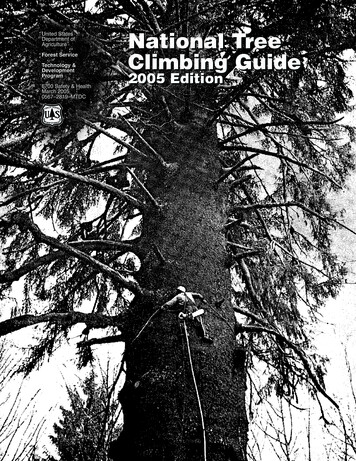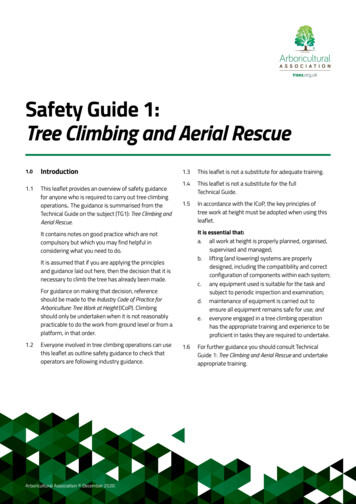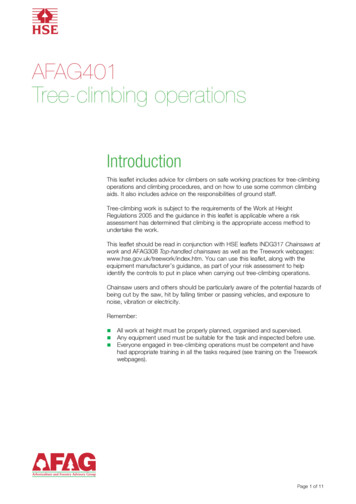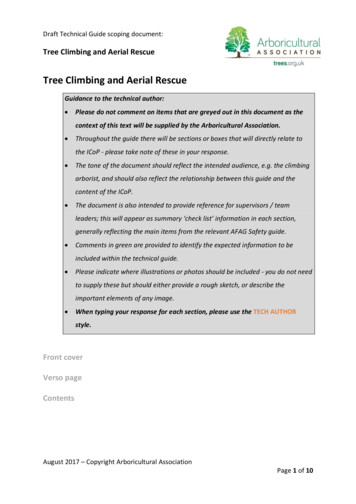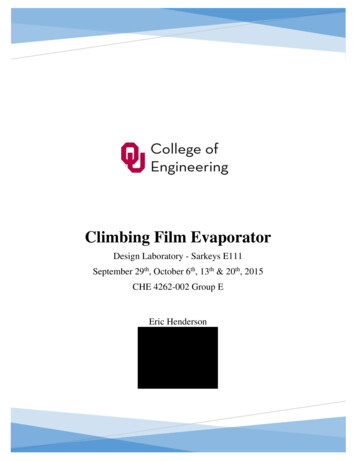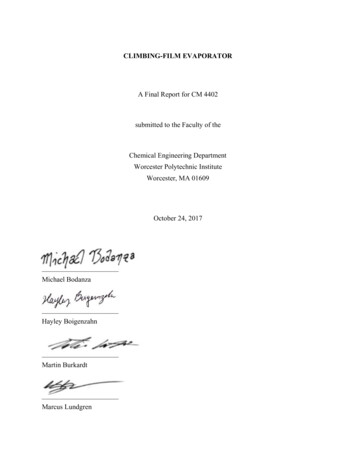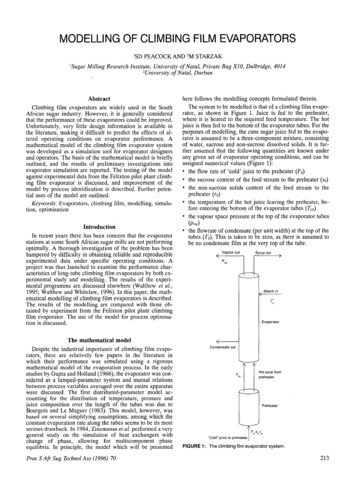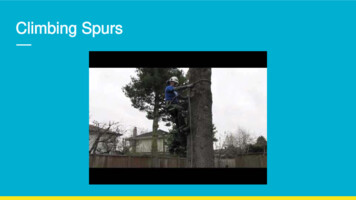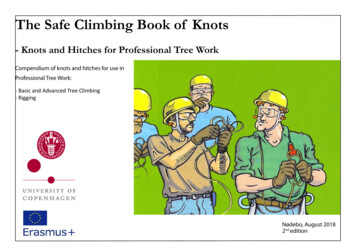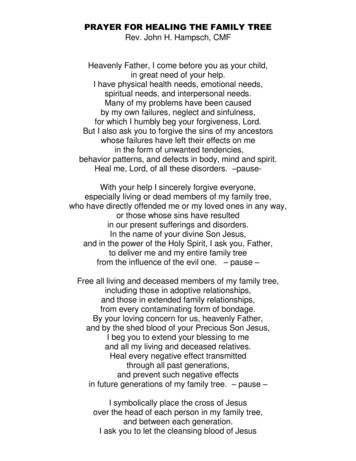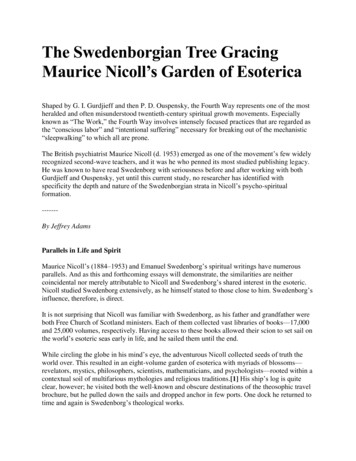
Transcription
National TreeClimbingGuideForestService6700 Safety and Occupational Health2470 SilvicultureApril 20151
National Tree Climbing Guide2015 Electronic EditionThe Forest Service, United States Department of Agriculture (USDA), has developed this informationfor the guidance of its employees, its contractors, and its cooperating Federal and State agencies,and is not responsible for the interpretation or use of this information by anyone except its ownemployees. The use of trade, firm, or corporation names in this document is for the information andconvenience of the reader, and does not constitute an endorsement by the Department of any productor service to the exclusion of others that may be suitable.*****USDA is an equal opportunity provider and employer. To file a complaint of discrimination, write:USDA, Office of the Assistant Secretary for Civil Rights, Office of Adjudication, 1400 IndependenceAve., SW, Washington, DC 20250-9410 or call (866) 632-9992 (Toll-free Customer Service), (800)877-8339 (Local or Federal relay), (866) 377-8642 (Relay voice users).
Table of ContentsAcknowledgments .4Chapter 1 Introduction .71.1 Training.71.2 Obtaining Climbing Equipment.81.3 Terms and Definitions.8Chapter 2 Preparations for Climbing .122.1 Job Hazard Analysis and Communications.122.2 Required Personal Protective Equipment.122.3 Working as a Team .122.4 Hazard Assessment .13Chapter 3 Equipment.173.1 Use of Climbing Equipment.173.2 Care of Climbing Equipment.173.3 Ropes .183.4 Webbing .233.5 Safety Equipment .253.6 Carabiners and Screw Links .273.7 Helmets .283.8 Slings (Safety Straps) .283.9 Basic Equipment List .29Chapter 4 Knots.314.1 Terms Used in Rope Work .314.2 Figure-8 Knots .324.3 Friction Hitches .324.4 Specialty Knots .354.5 Other Useful Knots .36Chapter 5 Tree Entry Methods .445.1 Climbing Spurs .445.2 Ladders .475.3 Line Installation .505.4 Single Rope Technique (SRT) .525.5 Doubled Rope Technique (DRT) .565.6 Tree Steps .582
Chapter 6 Working in the Tree.606.1 Three Point Climbing .606.2 Free Climbing .606.3 Four Inch Tie-In System .616.4 Lanyard Use .636.5 Handling Materials in Trees .64Chapter 7 Rappel Systems.687.1 Mechanical Rappel Devices .687.2 Friction Knots .697.3 Rigging .697.4 Rappelling .72Chapter 8 Rescue .748.1 Rescue Equipment .748.2 Rescue from Sectional Ladders .788.3 Rescue from Spurs .798.4 Rescue from SRT .808.5 Rescue from DRT .828.6 Rescue from Upper Reaches of the Tree Crown/Canopy .83Chapter 9 Using Chainsaws in Trees .849.1 Determining Whether a Chainsaw is Needed .849.2 Chainsaw Endorsement Categories (EC) .849.3 Prerequisites for Chainsaw Operators EC1, 2 and 3 .849.4 Prerequisites for Chainsaw Operators EC4 .849.5 Prerequisites for Chainsaw Instructors .849.6 Equipment .859.7 Working in the Tree with a Chainsaw .85Chapter 10 Recommended Publications .873
AcknowledgmentsThere are many Forest Service employees whose work has helped us produce the National TreeClimbing Guide. Specifically, we would like to acknowledge:Primary Authors/EditorsEarly Versions Guide Authors/EditorsJerry BerdeenJerry BerdeenBurnham ChamberlainBurnham ChamberlainTeryl GrubbTyler GrooArt HendersonDale KaneBrock MayoChuck McDonnellManfred MielkeDennis RingnesKathryn PurcellDonna StubbsDennis RingnesRobert WalkowiakMarc RobertsDonna StubbsCover PhotoMicah ThorningPhotographer: Leo FremontiClimber: Mark LinnellOther Guide ContributorsJosh AlonzoEric ForsmanKevin Freeman (APHIS)Dennis HeltonGwen B. HensleyCarol MoreheadRae WatsonWendi WeaverLisa Winn4
The National Tree Climbing Guide is a product of the National Tree Climbing Program TechnicalAdvisory Group (TAG), as authorized by FSH 2409.17, Chapter 50.National Tree Climbing Program Technical Advisory Group 2015National Program Leader. Lisa WinnRegion 1Coordinator. Shelah CoxTechnical Advisor. Mike GieseyRegion 3 and Rocky Mountain Research StationCoordinator. Craig WilcoxTechnical Advisor. Chad RiceRegion 4Region 5Coordinator. Ian QuistTechnical Advisor. Brett BittenbenderTechnical Advisor.Todd FranzenCoordinator . Dan OHalloranTechnical Advisor. Steve MurphyTechnical Advisor.Rick RatajPacific Southwest Research StationCoordinator. Kathryn PurcellTechnical Advisor. Craig ThompsonRegion 6 and Pacific Northwest Research StationCoordinator.Loretta DukeTechnical Advisor.Brock MayoTechnical Advisor. Daren BelsbyRegion 8, Region 9 and Southern Research StationCoordinator.Dan PetersenRegion 8 Technical Advisor.Micah ThorningRegion 8 Technical Advisor. Art HendersonRegion 9 & SRS Technical Advisor.Paul ValentoNorthern Research StationCoordinator. Marc RobertsState and Private Forestry Northeastern AreaCoordinator.Manfred MielkeUSDA APHISMassachusetts Coordinator. Kevin FreemanNew York Coordinator.Mathew RoachOhio Coordinator.Marvin Enoe5
Excerpted from FSH 2409.17, Chapter 50.51.08 - National Tree Climbing Program Technical Advisory GroupThe National Tree Climbing Program Technical Advisory Group, composed of the National TreeClimbing Program Manager, the tree climbing coordinators at the regions, stations, area, andinstitute, and tree climbing technical advisors, performs the following:1.Provides program recommendations to the National Tree Climbing Program Manager.2.Provides operational and technical advice to Forest Service Tree Climbers.3.Serves as a board of appeal on issues relating to tree climbing.4.Recommends changes to the Forest Service Tree Climbing Program policy in section 51.03and to the technical guidelines referenced in the National Tree Climbing Guide.5.Establishes and/or approves tree climbing training programs through which applicants forcertification can satisfy the requirements of section 51.3.6.Establishes criteria for equipment selection, approval, and use.7.Approves the use of new equipment, techniques, and practices.8.Addresses national issues at annual National Tree Climbing Program workshops.6
Chapter 1 IntroductionThe Forest Service Tree Climbing Program provides direction that protects Forest Service employeeswhile ascending, descending, and working aloft in trees by establishing national direction based onrecognized industry standards, procedures and practices.Climbing and working in trees demands specialized equipment and skills. The potential for aserious injury or fatal fall is always present, so employees shall be trained and certified beforethey engage in tree climbing operations and activities. The Forest Service Silvicultural PracticesHandbook, FSH 2409.17, Chapter 50-Forest Tree Improvement, shall be followed.Tree climbing is arduous, demanding work that requires upper body strength and overall flexibility.Besides being physically fit, you must be able to identify and compensate for any physical ormental condition that might temporarily impact your climbing ability. Compensating may meannot climbing until the condition is no longer a problem.Tree climbing work can be hazardous and hazardous duty pay is appropriate as outlined in theForest Service Manual (FSH 6109.12.92b).1.1 TrainingOnly Forest Service employees who hold a valid tree climbing certification card issued by theForest Service may engage in tree climbing. All tree climbers must be trained and certifiedbefore commencing work projects and activities. Tree climbers must use only the techniques andequipment they are certified to use.Applicants for tree climbing certification must possess an American Red Cross first aid certificationor equivalent, and demonstrate the required knowledge and skills of the certification level forwhich they have applied. Trainees must pass a written or verbal examination that demonstratestheir knowledge of at least the following:1.Safety requirements set forth in the National Tree Climbing Guide and FSH 2409.17,Chapter 50,2.Identifying, mitigating and/or reporting hazards associated with tree climbing work,3.Function, care, use and maintenance of tree climbing equipment.4.Trainees must also demonstrate their ability to safely perform the following minimumrequirements after completion of the written or verbal examination:A. Successfully tie all task specific knots,B. Demonstrate proficiency in tree climbing using the three-point climbing technique,including installation of a lanyard and limbing-over on a task specific basis,C. Perform an aerial rescue using an approved rappel system.D. Training must be conducted by at least one certified Tree Climbing Instructor, whomay certify the trainee as a Tree Climber Trainee, or Tree Climber. Applicants for TreeClimbing Instructor certification must successfully complete a basic tree climbinginstructor training workshop, and meet the approval of the Evaluating Facilitator(s).Tree climbing certification is valid until the end of the calendar year three years afterissuance, unless revoked earlier.7
Work supervisors should promptly withdraw a climber’s certification or remove the climber fromclimbing
2. Provides operational and technical advice to Forest Service Tree Climbers. 3. Serves as a board of appeal on issues relating to tree climbing. 4. Recommends changes to the Forest Service Tree Climbing Program policy in section 51.03 and to the technical guidelines referenced in the National Tree Climbing Guide. 5. Establishes and/or approves tree climbing training programs through which applicants for
